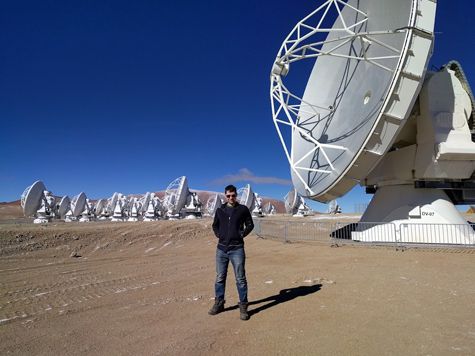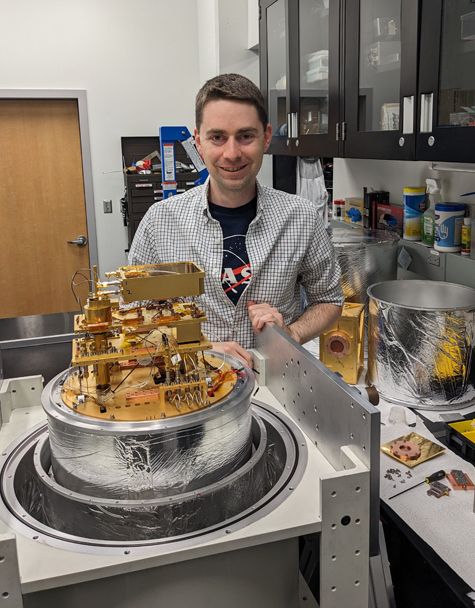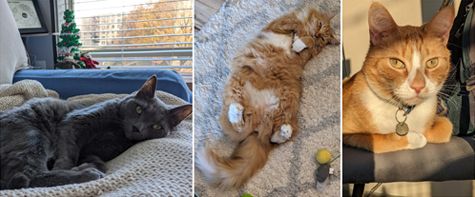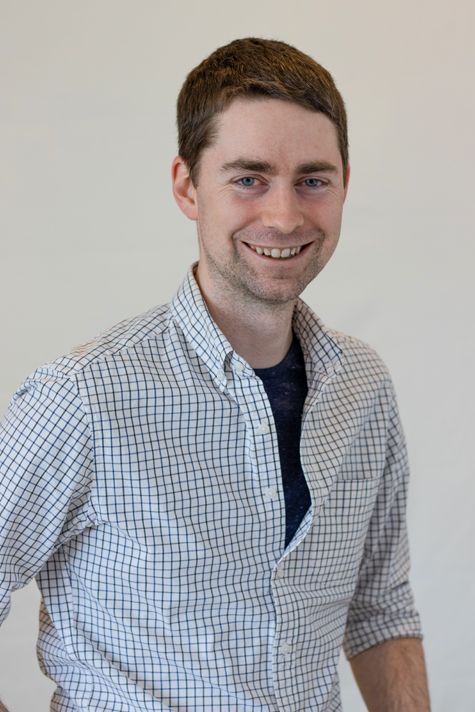Early Career Scientist Spotlight
Dr. Nicholas Cothard (he/him/his)
Observational Cosmologist
Observational Cosmology Laboratory (665)
What is your research focus?
Broadly speaking, my research is focused on developing instrumentation for future far-infrared (far-IR) astrophysics missions. Observing far-IR wavelengths lets us peer into the universe’s past and see through clouds of dust that otherwise obscure shorter wavelengths of light. Future far-IR observatories will probe a wide range of open astrophysics questions. For example, they will observe the growth of galaxies and black holes over cosmic time and will trace the evolution of the mass and contents of young solar systems. My work specifically contributes to a NASA mission concept called the PRobe far-Infrared Mission for Astrophysics (PRIMA). To accomplish PRIMA’s goals, the observatory needs exquisitely sensitive far-IR sensors, and that’s where I come in.
My primary research focus is developing ultrasensitive far-IR detector arrays, suitable for these future space-based observatories. I work closely with scientists and engineers at both Goddard and the Jet Propulsion Laboratory (JPL) to characterize state-of-the-art superconducting kinetic inductance detectors (KIDs). To demonstrate that these detectors will be suitable for future observatories, part of my job is to design and implement a testing facility to understand their behavior and to test them in a variety of simulated observing scenarios. After characterizing the properties of the prototype detectors, my team and I then iterate on the detector design to achieve the requirements for the observatory. My research also focuses on the technologies needed to support the detectors once they are integrated with a space telescope. For example, we’re developing novel far-IR metamaterial filters to place in front of our detectors so that they see only precisely defined wavelengths. We’re also developing the ability to fabricate micromachined microlens arrays to pair with our detector arrays, maximizing their light collecting ability. The superconducting detectors need to be operated at very low temperatures (colder than interstellar space!), so I also get to work on specialized cryogenic microwave electronics systems to read out the sensors.

Credit: Brian Koopman
Did you always know that you wanted to be an Observational Cosmologist?
No, not exactly. Before going to college, I knew I wanted to work in a STEM field, and I had a strong interest in physics. In my freshman year of college, I took an introductory astronomy course, which ended up being really tough and dissuaded me from pursuing astronomy as a major. So, I stuck with physics and was lucky enough to be able to explore several different physics subfields through various undergraduate summer research experiences. By the end of undergrad, I had explored particle physics, aeronomy, and plasma physics research. This was great, because it taught me a diverse set of lab skills and showed me that there is a significant amount of overlapping soft skills between every research field. Arriving at graduate school, I was pretty sure that I wanted to go into plasma physics, but, following the advice of mentors and friends, I decided to spend some time exploring other research labs around campus. This is how I stumbled into the world of millimeter and sub-millimeter wavelength experimental cosmology.
In the experimental cosmology lab, I contributed to building some of the world’s most sensitive ground-based microwave telescopes by tackling physics problems to develop new technologies. I was part of a few telescope collaborations, all based in the Chilean Atacama Desert, including the Atacama Cosmology Telescope, the CCAT Collaboration, and the Simons Observatory. Some of my favorite experiences in graduate school were at elevations of over 17,000 feet, working on instrumentation on these telescopes. My research involved designing and testing filters and superconducting detectors, for these telescopes. My research was support by a NASA Space Technology Research Fellowship (now called NASA Space Technology Graduate Research Opportunities), and through this program, I met my NASA mentor, Dr. Ed Wollack, a Goddard Research Scientist. While wrapping up my dissertation research, I applied to the NASA Postdoctoral Program (NPP) to continue my work on detectors and filters, but with a spin towards using the technologies for far-IR applications on space telescopes. Ed was an invaluable resource for learning about potential opportunities at Goddard and learning about how to apply. I was extremely excited to be awarded the position and have enjoyed being at Goddard since the fall of 2021. The support of my amazing mentors between undergrad and grad school helped open a lot of opportunities for me and helped me eventually find myself at Goddard.
What does a typical day of work look like for you?
Honestly, every day is different and that is one of the things I love most about this job. I’m typically in the lab every day, but my tasks vary widely depending on the different phases of my projects. Sometimes I spend my day bouncing between different labs and buildings around Goddard, interfacing with various teams while we prepare new detectors for a measurement campaign. Other times, I might spend most of the day in my lab running measurements or designing new hardware. Occasionally, things are quiet enough that I can work remotely while looking at some of our device data. Regular meetings with collaborators around the world are useful to structure my schedule around, but, from a day-to-day perspective, I enjoy the variety of research problems that I get to work on.
What aspects of your work excite you the most?
I’m excited about developing various emerging technologies, such as kinetic inductance detectors (KIDs), with the goal of using them to enable future discoveries. KIDs are superconducting detectors that can be used to sense far-infrared radiation. Part of my work is to show that we can make large arrays of KIDs that are “photon noise limited” meaning that they are so sensitive that they are limited by the brightness of the object they are observing rather than their own intrinsic detector noise. Being able to work on these challenges at Goddard, surrounded by creative thinkers and world-class research facilities, has been a wonderful experience. At the forefront of developing technologies, each day presents a unique set of research challenges. It’s so fun and exciting to work alongside brilliant scientists and engineers to solve these challenges. I enjoy that my work constantly involves solving new types of problems, requiring me to develop a diverse set of skillsets and to look at each problem from multiple perspectives. Once again, no day is the same!

Credit: Nicholas Cothard
What skills are most useful to you in your work, and where did you develop those skills?
As with most laboratory-based jobs, there are a lot of technical skills that I use daily during the design, fabrication, testing, and analysis phases of an experiment. For example, I work with electronics, cryogenics, vacuum systems nearly every day, and I enjoy automating laboratory measurements by developing hardware control software. I also use a lot of data analysis skills, for example, when taking raw data in the lab or from a telescope and reducing it into something physically meaningful for my projects. I primarily developed these skills on-the-job over the course of my research experiences throughout my undergraduate and graduate education, and I continue to develop them each day at Goddard.
In contrast to lab-based skills, however, I find that team-based skills are equally if not more useful. New lab-based skills will almost always need to be developed when starting a new job or joining a project, and this is expected by most employers. But team-based skills, such as communication, creativity, and time management, are critical from day one of a project, and are often highly transferable between jobs. Unfortunately, these skills are rarely taught or emphasized in STEM fields even though they are skills that we all use day in and day out. Being able to work and communicate with others effectively in a collaborative and respectful environment is key to the success of a team. Beginning to consciously develop these skills early on in high school and college (through, for example, clubs, sports, tutoring, or experimental lab courses) is very important. I think of team skills as life skills that I will continue to grow throughout my career as a scientist.
What early career advice do you have for those looking to do what you do?
First, as early as possible, try to find opportunities to explore what the research world is like. For example, check out career fairs, take research project courses in college, apply for summer research or internship opportunities, or talk to your favorite professors or department administrators about how to get involved in the department. Don’t be afraid to try different subjects and push outside your research comfort zone. I think trying as many opportunities as possible is great because it exposes you to a bunch of different perspectives on how science works and it may lead to finding a great mentor, or maybe even your dream research field. Secondly, I don’t think I can understate the importance of finding good mentors. Find people that you enjoy working with and who are excited to work with you and answer your questions. All the best scientists love answering questions. My last piece of advice is don’t forget to take a step back every once in a while to remember the bigger picture of what you’re trying to accomplish and to appreciate all of the work you’ve done to get yourself to where you are today.

Credit: Nicholas Cothard
What do you like to do in your free time?
Most of my hobbies involve getting outdoors and away from the lab. I like to go hiking, running, and kayaking with my partner, Jenn. During the pandemic, I enjoyed learning about all the different ways to make great coffee at home. And I probably spend too much of my free time playing with and taking photos of our three cats.
Biography
Home Town:
Elmhurst, Illinois
Undergraduate Degree:
BS in Physics, University of Rochester, Rochester, NY
Post-graduate Degrees:
PhD in Applied Physics, Cornell University, Ithaca, NY

Link to Dr. Cothard's GSFC Bio
